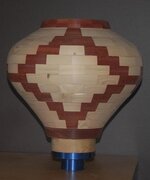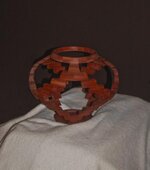gwilki
Member
I've not been turning pens for a while, but since the "other" board is here, I thought I would post my most recent attempt.
The first pic shows it with the waste pieces still in place, to give a better idea of the pattern and shape. They were just cut up 2 x 4.
The piece is bloodwood. No finish on it yet. I don't know if I like it enough to put a finish on it.
It stand about 10" tall and is about 11" in diameter at its widest.
A great deal of credit for the process goes to Dennis Edwards and David Vannier. I'm just the guy with the wood.
Tks for looking.
The first pic shows it with the waste pieces still in place, to give a better idea of the pattern and shape. They were just cut up 2 x 4.
The piece is bloodwood. No finish on it yet. I don't know if I like it enough to put a finish on it.
It stand about 10" tall and is about 11" in diameter at its widest.
A great deal of credit for the process goes to Dennis Edwards and David Vannier. I'm just the guy with the wood.
Tks for looking.


